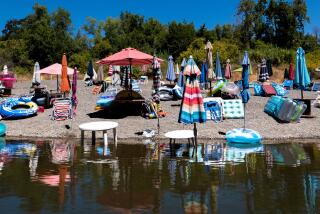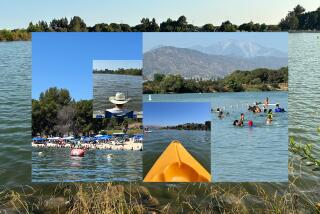Chopper Waters : More Affordable and Easier to Use Than Other Vessels, Personal Craft Gain Popularity and a--Somewhat Deserved--Reputation
- Share via
If you think of them as waterborne motorcycles, you’ll come fairly close to understanding both the great popularity and the criticism that continues to swirl around the machines that are known collectively as “personal watercraft.”
The growing number of people in Orange County who ride these sit-down powerboats with handlebars praise them as affordable, sporty, quick, highly maneuverable, exciting and just plain fun.
Some other county boaters and waterborne law-enforcement officials, however, can be less-enthusiastic. Boaters complain of reckless riders violating marine-safety rules and ruining a usually calm environment with high-decibel engine noise. Orange County Harbor Patrol officers say accidents involving personal watercraft, sometimes resulting in serious injury, are on the increase in county coastal waters.
In California, personal watercraft can legally be operated by anyone age 12 or over (or younger if someone 18 or over is aboard), and no training or license is required.
In short, they are easy to own, easy to operate and, in the hands of the inexperienced, sometimes easy to crack up.
And they are very popular. Last year, the 17,142 registered personal watercraft in Orange County represented nearly a quarter 23.9% of all registered vessels.
Statewide, the percentage is 13% of registered vessels. But the 257 accidents reported last year accounted for 36% of the state’s boating mishaps. There were seven fatalities.
In Orange County, Sheriff’s Harbor Patrol Lt. Dick Olson said there have been 11 accidents involving 15 personal watercraft through July of this year.
“Most of those accidents resulted in some type of injury,” he said. “It’s just this year that we’ve started to have problems.”
Harbor Patrol Sgt. Howard Mol said the total is certain to rise this year as more and more boaters put to sea astride personal watercraft. The vessels are particularly popular--and the accident rate higher--at Dana Point Harbor than other county coastal areas.
“It’s so popular [at Dana Point Harbor] because of the short distance of the launch ramp from the ocean. The speed limit in the harbor is 5 m.p.h., but they can be out of the entrance channel and into the ocean, where they can go faster, in a matter of minutes.”
A personal watercraft is often called a Jet Ski, but that’s a misnomer. Jet Ski is a trade name used by Kawasaki Motors to describe a type of personal watercraft operated from a standing position. That craft, say retailers and others, has steadily declined in popularity as the sit-down models, manufactured by a handful of companies as well as Kawasaki, have emerged. Many riders, they say, simply find wave-hopping in a standing position too strenuous.
The sit-down versions seem to be popular with owners nationwide.
Last year, personal watercraft accounted for 31% of all motorized vessels sold in the United States. The average price for one was about $5,600, said John Birkinbine, the executive director of the Chicago-based Personal Watercraft Industry Assn.
Paul DeMaio of Aliso Viejo and his wife bought their first personal watercraft a year ago after getting rained out of a day at Disneyland. The pair decided to “putter around and go to a few shops instead.”
“We saw one, and it was much less than we expected to pay--$6,900 out the door. We just jumped on it.”
The DeMaios had been going to the Colorado River regularly for 10 years and watching the number of personal watercraft there increase. After a year of piloting their own two-seat model they bought a three-seater, which can legally tow water-skiers and inner tubers. Learning to ride, he said, was no problem.
“A monkey could operate these things,” DeMaio said. “They’re very user-friendly. It’s not a balance issue at all. The most important thing, though--and a lot of people forget this--is learning the rules on the water. Because for all intents and purposes [a personal watercraft] is a boat, and you have to learn to use it properly.”
Neither he nor his wife has ever had an accident or a close all, DeMaio said, but he added that they avoid riding their craft on crowded days, such as the Fourth of July.
*
Depending on their size, personal watercraft can carry one to three people and can run at speeds from about 39 m.p.h. to around 60 m.p.h., said Bill Ritt, a sales associate at Newport Boats.
“And with a nine-gallon tank, you can go to Catalina with it and still have a gallon left over,” he said. “The bottom line is that they’re cheaper than a boat, and anybody can do it. You don’t have to have talent or balance; you just get on and go.”
Which, said the Harbor Patrol’s Mol, may be a problem. There is no law in California requiring people to learn how to operate the craft before they use it.
“They’re certainly a fun-type thing,” Mol said, “but in my opinion there should be some instruction required. People should know the basic boating laws and things like right-of-way and yielding and how to turn properly.”
Without formal instruction, such knowledge comes through experience, said the industry’s Birkinbine, and the less experience riders have, the more danger they may be in.
“Part of the problem is that people get on them and they’re having such a good time they forget that now they’re the captain of a boat and they have to abide by all the boating laws that apply to everyone else. That’s when they run into trouble, because they either don’t pay attention to the laws or they bother other people.
“The longer the period of time someone’s on the craft, the safer and the more law-abiding they are, partly because the novelty’s worn off. You could equate it to the time somebody spends on a motorcycle. The most dangerous time for them is the first six months.”
Birkinbine said the increasing accident rate involving personal watercraft is not only a result of the increasing number of those craft but the increasing number of inexperienced riders who are piloting a friend’s craft or a rental.
Also, he said, unlike conventional boats that may float at anchor or simply drift while the occupants are fishing or swimming, “when personal watercraft are in the water, they’re almost constantly in use.”
*
“There will always be idiots in one group or another,” said Ritt, the salesman. “I notice that you get young kids on them sometimes when their parents aren’t around, and they just want to punch it. Or you get kids who want to cross [another boat’s] wake and they don’t look at what’s around them.”
Unlike many accidents involving conventional boats, “alcohol doesn’t seem to be the problem here,” said Mol. “What we’ve experienced is just hot-dogging, reckless operation. Most of our accidents [around Dana Point] happen right off Capistrano Beach and Doheny State Beach with people wanting to show off their skills.
“There’s a maneuver called a power slide, a very quick maneuver, and the rider isn’t always totally aware of other craft in the vicinity. When you collide on something like that you’re totally exposed, so stand by for the injuries.”
However, said Birkinbine, the hot-doggers appear to be giving way to a new generation of buyers who ride somewhat more sedately, and on larger craft.
“The biggest segment of growth these days is in three-person craft,” he said. “They appeal more to families, and they’re also the most quiet and most stable. And every year the manufacturers are making them quieter.
“I think what we’re experiencing now is the end of the first generation of people using them. They were just like snowmobiles used to be, where people said they were too noisy and dangerous and people were calling for them to be banned. Now that they’ve been used a few years, people are finding that these are wonderful machines that can be a lot of fun, and they’re policing themselves.”
(BEGIN TEXT OF INFOBOX / INFOGRAPHIC)
HOW THEY WORK
Personal watercraft work much like a floating motorcycle.
They are powered by a gasoline engine, generally located beneath the seat. Thrust comes from an internal impeller that forces a jet of water out of a tube in the back of the craft. The engine is acceleratedby squeezing a handle attached to the right-hand handle grip. When the handlebars are turned, the tube is also turned in hat direction, pushing the craft around. The rider helps by leaning into the turn in much the same way a motorcycle rider does. If a rider falls off for any reason, a cord attached to the rider trips the “kill” switch, and the craft comes to a stop.
Construction materials, apart from the engine, are generally plastic and fiberglass. The engines are cooled by water sucked in from the outside.
If the craft is used in saltwater, manufacturers recommend the engine be flushed with fresh water after use.
WHERE TO GO
Lakes, rivers and coastal waters are all popular locations for using personal watercraft.
Launching fees at lakes and beaches range from $6 to $12; there are usually no fees at river locations.
* Ocean-close: Dana Point (Embarcadero Marina). $8 launch fee for first vehicle, $6 for each additional vehicle on the same trailer. A matter of minutes to reach the ocean.
* Not-so-close: Newport Beach (Newport Dunes Resort). $8 flat fee Monday-Thursday, $12 on weekends. Takes about 35 minutes to reach the ocean after launching.
* Other popular California spots: Long Beach Harbor, at Granada Street; Mission, Bay, San Diego; Cabrillo State Beach, San Pedro; Lake Elsinore; Lake Perris; Puddingstone Reservoir; Castaic Lake; Pyramid Lake
* Popular out-of-state spots: Colorado River; Lake Havasu, Ariz.; Lake Powell, Ariz.; Laughlin, Nev.
* Note: Officials with the state Department of Boating and Waterways adviser operators of personal watercraft to call ahead to make sure operation is permitted before going to a new area.
The Northern California city of Redding, for instance, prohibits the use of personal watercraft on the portion of the Sacramento River within city limits. (The Personal Watercraft Industry Assn. has a lawsuit pending against the city seeked to remove the restrictions.)
More to Read
Sign up for Essential California
The most important California stories and recommendations in your inbox every morning.
You may occasionally receive promotional content from the Los Angeles Times.










